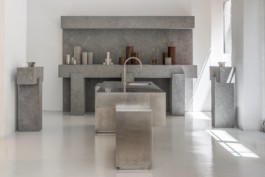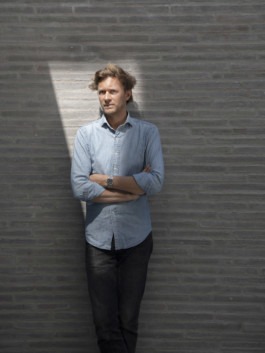



Obumex Signature Kitchen © NS ARCHITECTS
Interview
Architect <=> Designer, Selected by Nicolas Schuybroek
January 2023
COLLECTIBLE: Can you tell us a little bit about yourself?
Nicolas Schuybroek:
I was born and raised in Brussels and educated in English, French and Dutch-speaking schools. A multicultural background and extensive travel from the start has clearly nourished my work with a broad and international perspective.
Currently, the office is working on large-scale new-built houses, residential and art-related projects in Belgium, France, the Netherlands, the UAE, the USA, Taiwan, the UK, Canada and Indonesia.
As the practice develops, the projects are as diverse in geography and type as in scale. They range from renovations, new-builds and the interior design of residential projects, offices, hotels, retail spaces to the design of objects. The search for timeless minimalism and apparent simplicity remains central in all these projects, as well as the love of unassuming, tactile, and raw materials.
The essence of my work is to conceive serene and pure, yet extremely warm and authentic spaces. While my architecture is often described as monastic and minimalistic, it is sophisticated, and it always has a soul.
My works explore a sharp vision of space and materials and a rigorous, contextual approach: embracing the essence of built forms, from the roughest construction to the smallest interior details.
C: You are selecting architects for this new section at COLLECTIBLE, how can an architect approach/understand the design of an object in a different way than a designer?
NS: In my opinion, a hard line is difficult to draw between these disciplines: an architect is a designer and vice-versa. Both disciplines are interrelated given the intricate relationship between proportions and volumes, experience, and emotion. There are multiple ways of approaching and understanding the design of an object. It has been said so many times in different ways, but the fundamental difference between architecture and design is and will always remain the notion of scale.
C: Do you feel it is important that architects and designers work closely together and why so? What does this mean for the future of collectible design?
NS: I strongly believe in a wide range of co-creations. The synergy between different backgrounds and visions and disciplines is an essential part of our work. Conceptually, this continuously revolving door between designers, be it interior, object or furniture designers, architects, craftsmen and artists is and should be at the very core of what our practice represents – a permanent flux of inspiration and intellectual nourishment.
C: You have mentioned that you work based on creating ‘sacred proportions’ in your architectural work, how does this translate to your work in collectible design?
NS: A lot of time is indeed spent on the study of essential proportions and geometry related or not to classical or sacred architecture. Proportions help us to reinforce and navigate the quest for quietness and muted the spaces. They are not necessarily readable in a room, but they are defining the entire room.
The signature kitchen we released last year in Milan is a fairly good example of this. The starting point was to break the heaviness of the stereotypical typology of a kitchen island and instead create a sculptural shape as a derivative of our architecture: a very thought-through juxtaposition of blocks with shifts.
C: Do you or how do you see a development for a combined architectural and collectible design practice inside and outside the home? How do they inspire each other?
NS: Collectible design has been going strong for quite a while now. Since the early start of the practice, collectible design has always been part of the larger whole. This is part of our holistic design approach, where architecture, interior design, furniture and art, blend in and become stronger together. In general, people are shifting more and more from mass-produced items which in essence do not have a soul or story to tell.
C: As collectible design is rooted in a functionality and an emotional connection, which bears a resemblance to the architectural practice of living, how will this further develop in a future that requires more communality rather than individuality?
NS: This is a tricky question: I think indeed that collectible design stems from an individualistic perspective, where it is about a personal perspective the designer has on the world. In a certain way, collectible design is also about showing this individual identity. But I do not think that necessarily rules out collectible design for a larger audience. I think a designer, architect or artist can also address a certain ‘collective identity’ of a certain group with similar beliefs.

Portrait of Nicolas Schuybroek
About Nicolas Schuybroek
In 2011, Nicolas Schuybroek started his own practice based in Brussels, Belgium, with a well defined purpose: create and produce architecture, interiors and objects characterised by an acute sense of detail, craftsmanship and intuition, while retaining a feeling of warmth. The search for timeless minimalism and apparent simplicity are central in his work, as well as the love of unassuming, tactile and raw materials. There is no straining for effect in his work—just a muted elegance.
The essence of his work is to conceive serene and pure, yet extremely warm and authentic spaces. While his architecture is often described as monastic and minimalistic, it is surprisingly sophisticated and it always has a soul.
His works explore a sharp vision of space and materials. Most people recognise Nicolas’ hand through his rigorous and contextual approach: embracing the essence of built forms, from the roughest construction to the smallest interior details.
Interview
Architect <=> Designer, Selected by Nicolas Schuybroek
January 2023

Obumex Signature Kitchen © NS ARCHITECTS
COLLECTIBLE: Can you tell us a little bit about yourself?
Nicolas Schuybroek:
I was born and raised in Brussels and educated in English, French and Dutch-speaking schools. A multicultural background and extensive travel from the start has clearly nourished my work with a broad and international perspective.
Currently, the office is working on large-scale new-built houses, residential and art-related projects in Belgium, France, the Netherlands, the UAE, the USA, Taiwan, the UK, Canada and Indonesia.
As the practice develops, the projects are as diverse in geography and type as in scale. They range from renovations, new-builds and the interior design of residential projects, offices, hotels, retail spaces to the design of objects. The search for timeless minimalism and apparent simplicity remains central in all these projects, as well as the love of unassuming, tactile, and raw materials.
The essence of my work is to conceive serene and pure, yet extremely warm and authentic spaces. While my architecture is often described as monastic and minimalistic, it is sophisticated, and it always has a soul.
My works explore a sharp vision of space and materials and a rigorous, contextual approach: embracing the essence of built forms, from the roughest construction to the smallest interior details.
C: You are selecting architects for this new section at COLLECTIBLE, how can an architect approach/understand the design of an object in a different way than a designer?
NS: In my opinion, a hard line is difficult to draw between these disciplines: an architect is a designer and vice-versa. Both disciplines are interrelated given the intricate relationship between proportions and volumes, experience, and emotion. There are multiple ways of approaching and understanding the design of an object. It has been said so many times in different ways, but the fundamental difference between architecture and design is and will always remain the notion of scale.
C: Do you feel it is important that architects and designers work closely together and why so? What does this mean for the future of collectible design?
NS: I strongly believe in a wide range of co-creations. The synergy between different backgrounds and visions and disciplines is an essential part of our work. Conceptually, this continuously revolving door between designers, be it interior, object or furniture designers, architects, craftsmen and artists is and should be at the very core of what our practice represents – a permanent flux of inspiration and intellectual nourishment.
C: You have mentioned that you work based on creating ‘sacred proportions’ in your architectural work, how does this translate to your work in collectible design?
NS: A lot of time is indeed spent on the study of essential proportions and geometry related or not to classical or sacred architecture. Proportions help us to reinforce and navigate the quest for quietness and muted the spaces. They are not necessarily readable in a room, but they are defining the entire room.
The signature kitchen we released last year in Milan is a fairly good example of this. The starting point was to break the heaviness of the stereotypical typology of a kitchen island and instead create a sculptural shape as a derivative of our architecture: a very thought-through juxtaposition of blocks with shifts.
C: Do you or how do you see a development for a combined architectural and collectible design practice inside and outside the home? How do they inspire each other?
NS: Collectible design has been going strong for quite a while now. Since the early start of the practice, collectible design has always been part of the larger whole. This is part of our holistic design approach, where architecture, interior design, furniture and art, blend in and become stronger together. In general, people are shifting more and more from mass-produced items which in essence do not have a soul or story to tell.
C: As collectible design is rooted in a functionality and an emotional connection, which bears a resemblance to the architectural practice of living, how will this further develop in a future that requires more communality rather than individuality?
NS: This is a tricky question: I think indeed that collectible design stems from an individualistic perspective, where it is about a personal perspective the designer has on the world. In a certain way, collectible design is also about showing this individual identity. But I do not think that necessarily rules out collectible design for a larger audience. I think a designer, architect or artist can also address a certain ‘collective identity’ of a certain group with similar beliefs.

Portrait of Nicolas Schuybroek
About Nicolas Schuybroek
In 2011, Nicolas Schuybroek started his own practice based in Brussels, Belgium, with a well defined purpose: create and produce architecture, interiors and objects characterised by an acute sense of detail, craftsmanship and intuition, while retaining a feeling of warmth. The search for timeless minimalism and apparent simplicity are central in his work, as well as the love of unassuming, tactile and raw materials. There is no straining for effect in his work—just a muted elegance.
The essence of his work is to conceive serene and pure, yet extremely warm and authentic spaces. While his architecture is often described as monastic and minimalistic, it is surprisingly sophisticated and it always has a soul.
His works explore a sharp vision of space and materials. Most people recognise Nicolas’ hand through his rigorous and contextual approach: embracing the essence of built forms, from the roughest construction to the smallest interior details.
Contact
info@collectible.design
VIP PORTAL
EXHIBITOR PORTAL
PRIVACY POLICY
© 2025 Collectible
Contact
info@collectible.design
VIP PORTAL
EXHIBITOR PORTAL
PRIVACY POLICY
© 2025 Collectible